The Beginner’s Guide: Yasujiro Ozu, Director

Andrew Emerson is a University of Chicago student. His high…
When we think of Japanese cinema, Yasujiro Ozu usually isn’t the first name that comes to mind. In the West, his films have never been as widely distributed as Akira Kurosawa’s or Hayao Miyazaki’s. And if you actually have heard of Ozu, it’s likely because people have described his films as “slow” or “boring” (to quote some of the negative IMDb reviews for his Tokyo Story).
In reality, however, Ozu deserves much more exposure than he’s gotten. His films are not only thoughtful meditations on modern Japan, but they also subvert the stylistic conventions of mainstream filmmaking. Despite their apparently simplistic appearance, moreover, his films are often so open-ended that critics and scholars still can’t agree on how to interpret them.
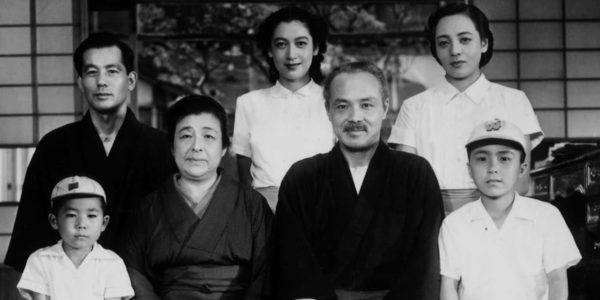
This guide will give an overview of Ozu’s life, his films’ reception, and some of their defining features. It’ll also suggest a good order to watch his films in, as well as some books you can read to learn more about him. Hopefully, you’ll come to see why Roger Ebert said that “To love movies without loving Ozu is an impossibility.”
Ozu’s Biography
To start with the basics: Yasujiro Ozu was born in 1903 in Tokyo. He began making films during the silent era and continued making them until the early 1960s. Shortly after releasing his final film, An Autumn Afternoon, he died on his 60th birthday of throat cancer.
Unlike the lives of some directors (e.g. Rainer Werner Fassbinder), Ozu’s life wasn’t exactly eventful. But several aspects of it are worth discussing. First, as a child, Ozu was an unabashed movie buff, and he would regularly skip school to go to the movies. His academic performance naturally suffered – to the point that he repeatedly failed his college entrance exams – but he acquired a deep appreciation of Western cinema that undoubtedly informed his decision to go into filmmaking.
It should also be noted that war interrupted Ozu’s filmmaking career on several occasions. Between 1937 and 1939, he fought in the Second Sino-Japanese War. Later, Japanese authorities sent Ozu to Singapore to make propaganda films, and in 1945, he spent six months in a British POW camp. Scholars still debate what views, if any, Ozu had on politics and his wartime experience, especially since he never really talked about either.
Finally, Ozu’s films reflect aspects of his personal life. Many of them take place in Tokyo, center on conflicts between parents and children, and feature old men who drink too much. None of this should come as a surprise, since Ozu spent most of his adult life in the greater Tokyo area, lived with his mother until her death, and had a lifelong problem with drinking.
Reception
During his lifetime, Ozu’s films were quite popular in Japan. They were frequently praised by Kinema Junpo, Japan’s oldest film magazine, and they often won accolades at the prestigious Mainichi Film Awards. Yet while Japanese film authorities eagerly distributed films like Kurosawa’s Rashomon outside of Japan, they refused to do the same for Ozu’s films, fearing that Ozu’s works were “too Japanese” to be appreciated by Westerners.
Perhaps somewhat ironically, Ozu’s films only began to be shown outside of Japan after his death. The good news, however, is that they immediately received acclaim – and among critics, their reputation has only grown in the ensuing decades. A 2012 Sight & Sound poll ranked Ozu’s Tokyo Story and Late Spring as, respectively, the third- and 15th-greatest films ever made.
Even though critics generally agree on the value of Ozu’s films, however, interpretations of Ozu still diverge. Some people view Ozu’s films as “quintessentially Japanese,” conservative works that are defined by a minimalist style and a focus on family relations. Conversely, others have argued that Ozu is actually a liberal experimentalist, a subverter of artistic convention whose films are just as much about Japanese history as family. In a sense, it’s a sign of Ozu’s greatness that his films remain open to so many different interpretations.
Defining Features
Here are some things to look out for when watching Ozu’s films:
Family and Intergenerational Conflict
In one way or another, all of Ozu’s films take an interest in family. If you just watched his best-known works (e.g. Late Spring and An Autumn Afternoon), you’d be tempted to think that his films are always about parents who want to marry off their young daughters. But his works revolve around other narrative tropes as well, like parents visiting their estranged grownup children (e.g. Tokyo Story, Floating Weeds, The Only Son) and young children who despise their parents (e.g. Good Morning and I Was Born, But…).
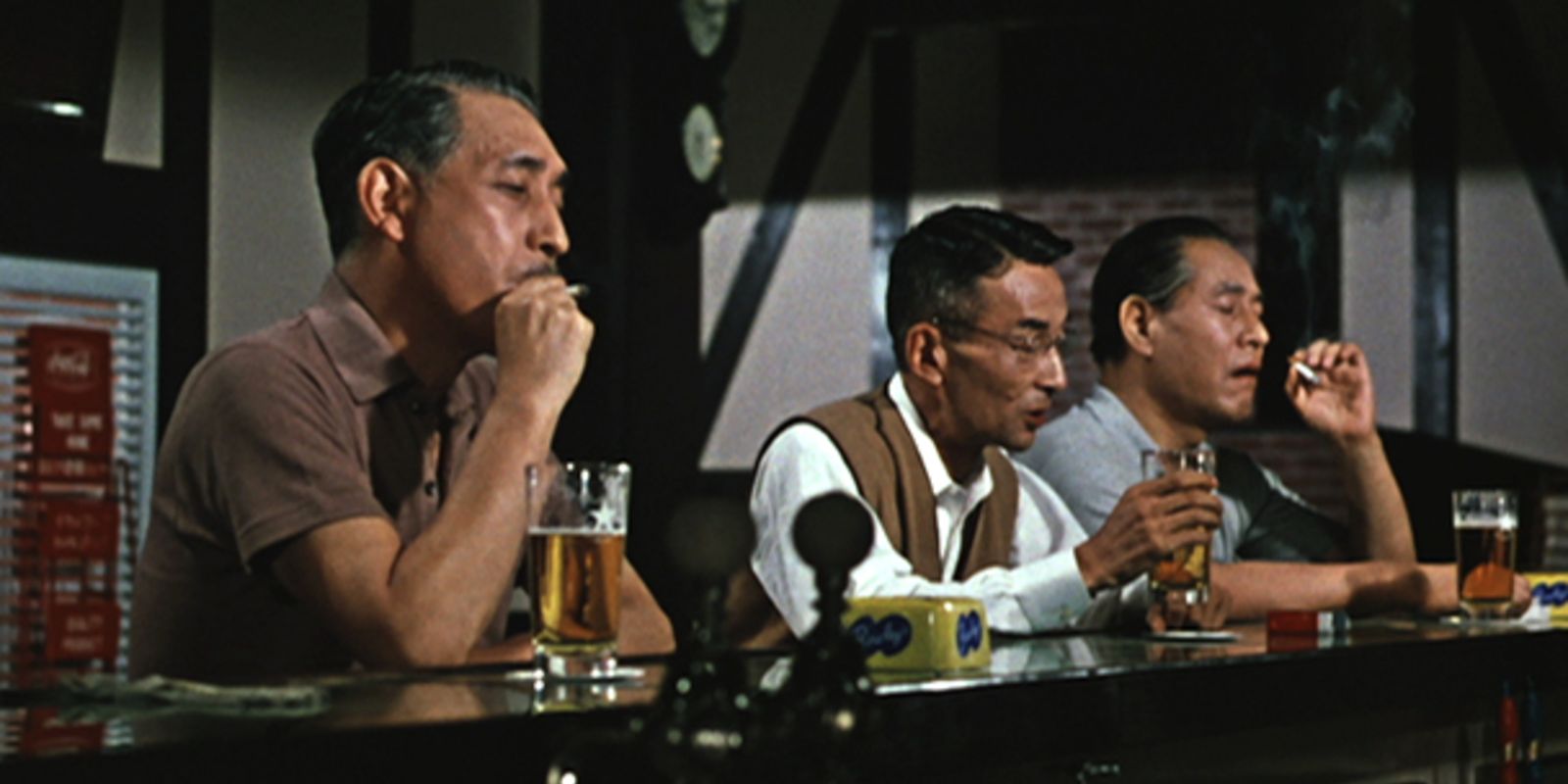
Broadly speaking, Ozu’s films typically feature conflicts between altruism and self-interest. The parental figures in his films are often traditionalists who make great sacrifices to do what they think will make their children happy. Conversely, Ozu’s younger characters are usually more Westernized individualists who have trouble appreciating and understanding their parents’ thinking. In many of Ozu’s films, this generation gap ultimately brings about misunderstandings, bitter arguments, and breakdowns in once-harmonious familial relations.
Not-So-Conservative Gender Roles
At first glance, Ozu’s characters conform to conservative conceptions of gender roles. The women are almost always housewives, and the few who do work outside the home are usually just office secretaries. Conversely, the male characters typically work as doctors, businessmen, or teachers.
This apparent conservatism, however, often belies a stinging critique of patriarchal norms. Although Ozu’s male characters are frequently in a position of power, that doesn’t mean they’re always lionized. In films like Late Autumn and Floating Weeds, they’re portrayed as sexually impotent bullies, while in works like An Autumn Afternoon, the male protagonists come off as passive figureheads.
Just as significantly, Ozu’s female characters are often quite sympathetic. In works like Early Summer, Late Spring, and Late Autumn, the female protagonists are young women with vivacious and strong-willed personalities. When these women are eventually married off, moreover, their marriages are depicted as something sad, as though their individuality were being suppressed for the sake of rigid social norms.
The upshot of all of this is that Ozu’s films are nowhere nearly as retrograde as they might seem. Their male characters are frequently portrayed as self-important, helpless, or manipulative, and their female characters are often anything but subservient or passive. These films aren’t the Japanese version of Thelma & Louise, but they undeniably do a good job of highlighting gender inequities in 20th-century Japan.
War and Occupation
As mentioned earlier, Ozu rarely talked about politics. Arguably, however, many of his films have a latent and frequently overlooked political dimension. In particular, several of his post-World War II films can be read as allegories for how Japanese people dealt with memories of the war and the Japanese empire.
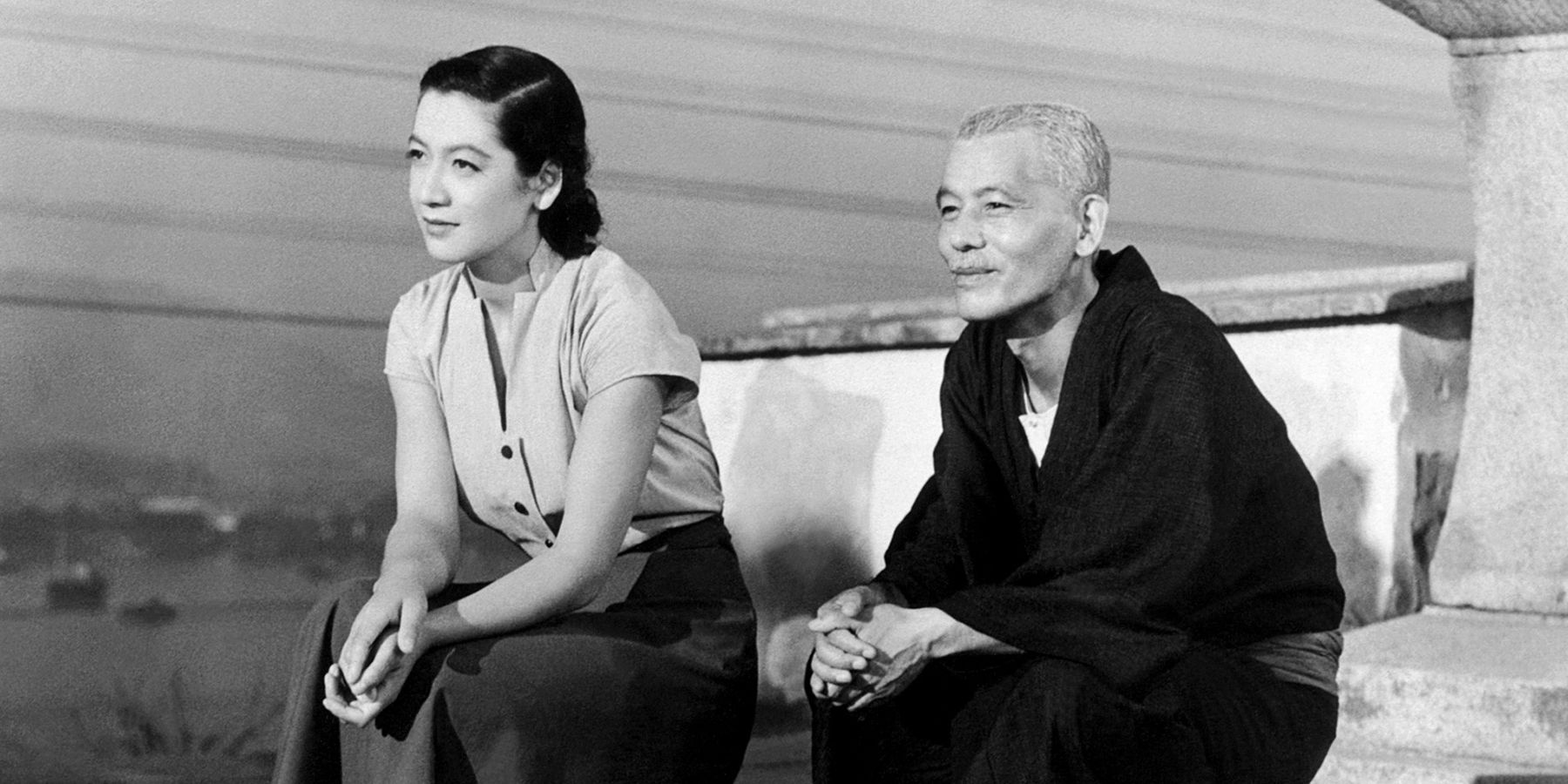
Perhaps the most obvious example of such an allegory is Tokyo Story. The protagonists are two parents who lost a son during the war. While they struggle to connect with their remaining children, they bond with their dead son’s widow, the only other major character who was personally affected by the war. At one point, moreover, the three of them go on a bus tour of Tokyo that conveniently omits any information about the vast damage that the city suffered from Allied bombings.
Read in this way, Tokyo Story plays as a subtle critique of historical amnesia. Invariably ostracized by other characters, the two parents and their daughter-in-law symbolize the rapidity with which Japanese people turned away from wartime nationalism and embraced the American occupation. In this sense, the overall film offers a portrait of political hypocrisy and the bewildering, even maddening plasticity of mid-20th-century Japan.
Tradition vs. Modernity
Many of Ozu’s films reflect on Japanese history. To be more precise, they juxtapose what you could call “traditional” Japan – the Japan of Buddhism, Noh theater, kimonos, and so on – with the “modern” and more Westernized Japan that emerged after the Meiji Restoration.
As you’ll quickly come to see, Ozu is hardly a fan of modernity. In films like The Only Son, Late Spring, Late Autumn, and An Autumn Afternoon, he suggests, among other things, that economic modernization has engendered inequality, feelings of alienation, empty consumerism, and the Americanization of Japanese life.
Even as he roundly criticizes aspects of modernity, however, Ozu doesn’t necessarily love traditional Japan, either. In films like Early Summer, he rebukes traditional culture’s patriarchal norms, and in works like There Was a Father and I Was Born, But…, he also criticizes Japanese nationalism. To watch Ozu’s films, in this sense, is to confront an unpleasant binary – a past with harmful traditions, and a present in which a uniquely “Japanese identity” has all but ceased to exist.
An (Ironically?) Peaceful Appearance
Stylistically speaking, Ozu’s films, particularly his postwar ones, stand out for their elegant and apparently peaceful appearance. The actors usually eschew emoting in favor of stoicism. The mise-en-scène is often characterized by parallel lines and right-angled shapes. The camera almost never moves. And the soundtrack frequently consists of music that sounds light and cheerful.
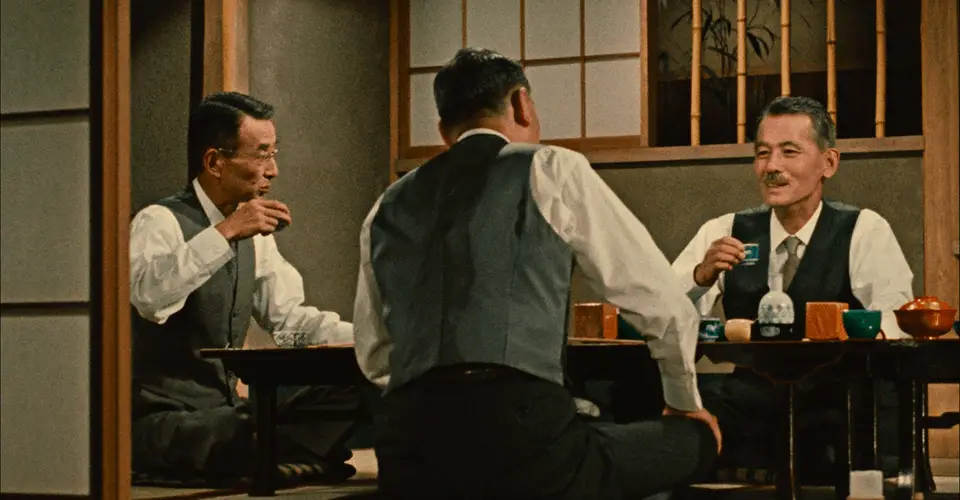
There are several ways you could interpret these stylistic choices. Some critics argue that these choices speak to Ozu’s “Zen worldview,” a minimalist approach that embodies a peaceful (if somewhat resigned) acceptance of change and suffering. Conversely, others argue that Ozu’s peaceful style is ironic, offering a quietly scathing depiction of emotional repression, motivated forgetting, and social conformity.
Violating Classical Stylistic Conventions
Ozu’s films often violate the stylistic conventions of mainstream filmmaking. For example, one “rule” in classical Hollywood cinema is that every shot should clearly and obviously advance the narrative. Yet Ozu’s films frequently feature what commentators call “pillow shots” – namely, shots of landscapes, objects, or interiors that have no apparent connection to the protagonists and what they’re doing plotwise.
Ozu’s films also reject the conventional way of shooting dialogue scenes. Normally, films follow the so-called “180-degree rule,” which makes it look like two characters are looking at one another as they talk. In Ozu’s films, however, this rule is repeatedly violated – and in a way, it’s a sign of his skill that you rarely notice these violations.
Lastly, in mainstream Hollywood films, the main action typically takes place in the foreground of every frame, and things in the background only play an incidental role. By contrast, shots in Ozu’s films often place characters in the background, while seemingly irrelevant objects (tables, bottles of beer, etc.) take up the foreground.
Even now, people still debate the significance of Ozu’s stylistic innovations. To some, his techniques obliquely highlight aspects of the characters’ psychology, like feelings of alienation, inner peace, or repressed despair. To others, however, these techniques don’t serve a narrative purpose. Rather, by drawing our attention to the film’s style, these techniques challenge the conventional notion that style should always be subordinate to the narrative.
Elliptical Storytelling
Finally, Ozu’s films typically avoid showing “important” events in the narrative. For instance, Late Spring and An Autumn Afternoon are about young women who get married off. Yet in both cases, Ozu doesn’t depict the actual wedding: instead, he focuses on how other characters talk about the wedding before and after it takes place.
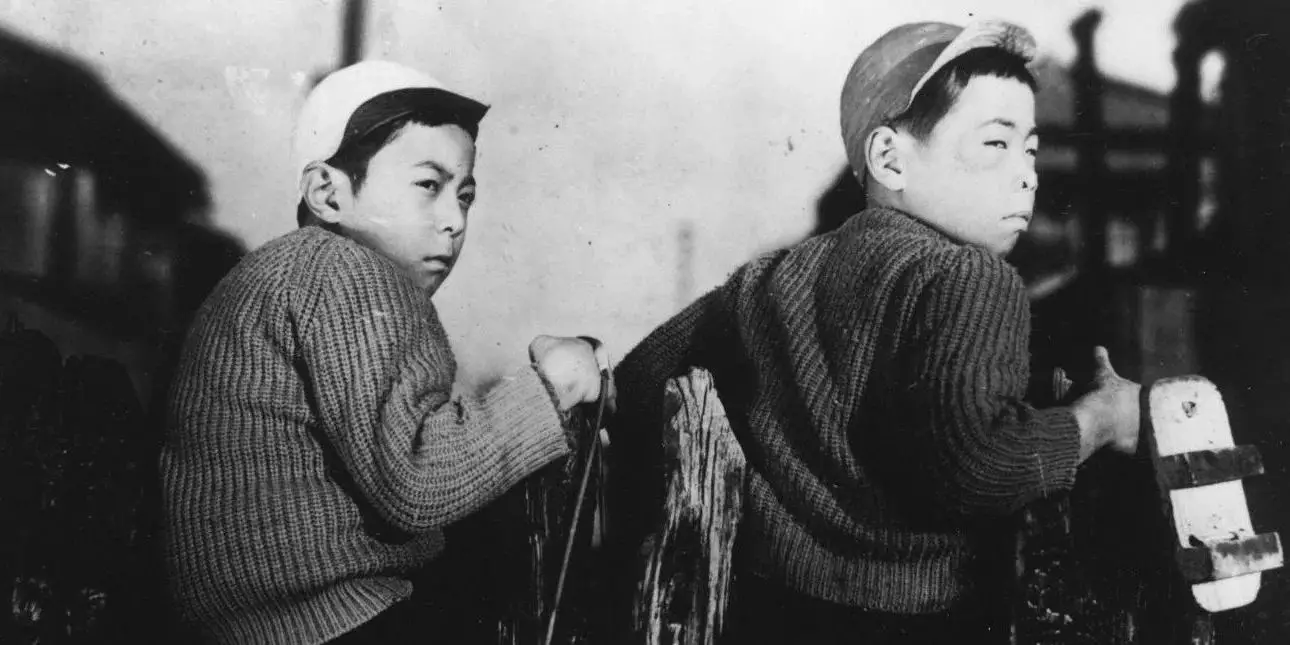
Among other things, this elliptical approach serves two purposes. By showing how people talk about important events, for one, Ozu places these events within the context of a larger community, thereby reminding us of the role that social norms play in his characters’ lives. More broadly, Ozu’s omission of important events also speaks to his interest in the mundane, his desire to uncover the emotional nuances within small talk, daily routines, and other “boring” details of everyday life.
Where to Start
Ozu’s style and worldview can take some getting used to, so if you haven’t seen his films before, the best place to start is probably Good Morning. A rather scathing critique of consumerism, the film often plays as a Japanese version of Jacques Tati’s Mon Oncle. And while Ozu is frequently characterized as a “quiet” and “serious” filmmaker, Good Morning offers a useful reminder that he had a very cheeky sense of humor.
Good Morning aside, one thing you often hear about Ozu is that “all of his films are the same.” Naturally, that statement is a gross simplification. But it does speak to the fact that most of his films are equally “difficult” in terms of content and style.
For the thrifty, the good news is that many of Ozu’s best-known works are easily accessible. Thanks to the wonders of technology, Tokyo Story, Late Spring, and An Autumn Afternoon are available to stream on many platforms, including YouTube, Amazon, and iTunes.

As wonderful as they are, however, these three films are only a small part of Ozu’s filmography, and if you have the time, you shouldn’t overlook his other works. The Criterion Collection has released DVD editions of Floating Weeds, Early Summer, Late Autumn, and Early Spring, and several of these can also be found for free on YouTube.
Finally, you shouldn’t forget about the films that Ozu made before and during World War II. Although critics tend to focus on the films he made in the 1950s and 1960s, his prewar films are just as powerful, and in some respects, they’re even darker than his later works. Particular standouts include I Was Born, But…; A Story of Floating Weeds; The Only Son; and There Was a Father.
Further Reading on Ozu
Many books have been written about Ozu. But the following four best speak to the differences in how he has been interpreted over the years. Broadly speaking, Richie and Schrader promote the idea that Ozu was a conservative, “quintessentially Japanese” director. Conversely, Bordwell and Yoshida characterize Ozu as a liberal and experimental filmmaker who challenged prevailing artistic norms.
Bordwell, David. Ozu and the Poetics of Cinema. Princeton, NJ: Princeton University Press, 1988.
Richie, Donald. Ozu: His Life and Films. Los Angeles: University of California Press, 1974.
Schrader, Paul. Transcendental Style in Film: Ozu, Bresson, Dreyer, With a New Introduction. Oakland, CA: University of California Press, 2018.
Yoshida, Yoshishige. Ozu’s Anti-Cinema. Translated by Daisuke Miyao and Kyoko Hirano. Ann Arbor, MI: University of Michigan Press, 2003.
The following two books discuss the historical and political context in which Ozu made his films:
Dower, John. Embracing Defeat: Japan in the Wake of World War II. New York: W.W. Norton, 1999.
Duus, Peter. Modern Japan. Boston: Houghton Mifflin, 1998.
Have you seen any of Ozu’s films? If so, what did you think? Please share your thoughts in the comments!
Does content like this matter to you?
Become a Member and support film journalism. Unlock access to all of Film Inquiry`s great articles. Join a community of like-minded readers who are passionate about cinema - get access to our private members Network, give back to independent filmmakers, and more.
Andrew Emerson is a University of Chicago student. His high school English teacher once asked him to read a batch of Roger Ebert’s reviews for class, and he’s been fixated on the idea of writing about movies ever since. You can follow his attempts to pursue this obsession at http://filmwatcher.net/.














